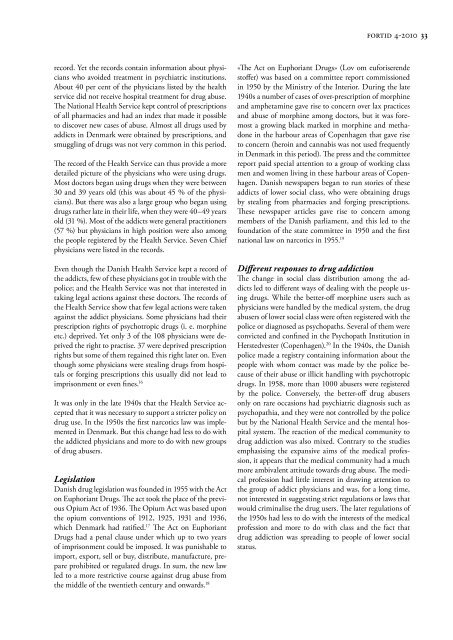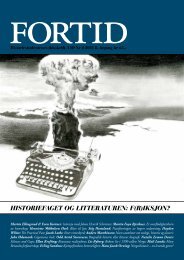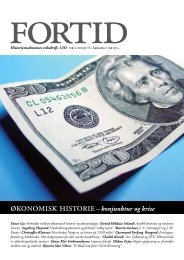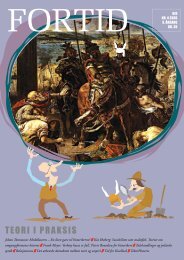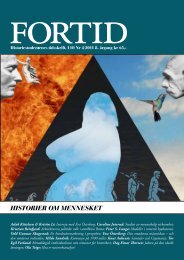You also want an ePaper? Increase the reach of your titles
YUMPU automatically turns print PDFs into web optimized ePapers that Google loves.
ecord. Yet the records contain information about physicians<br />
who avoided treatment in psychiatric institutions.<br />
About 40 per cent of the physicians listed by the health<br />
service did not receive hospital treatment for drug abuse.<br />
The National Health Service kept control of prescriptions<br />
of all pharmacies and had an index that made it possible<br />
to discover new cases of abuse. Almost all drugs used by<br />
addicts in Denmark were obtained by prescriptions, and<br />
smuggling of drugs was not very common in this period.<br />
The record of the Health Service can thus provide a more<br />
detailed picture of the physicians who were using drugs.<br />
Most doctors began using drugs when they were between<br />
30 and 39 years old (this was about 45 % of the physicians).<br />
But there was also a large group who began using<br />
drugs rather late in their life, when they were 40–49 years<br />
old (31 %). Most of the addicts were general practitioners<br />
(57 %) but physicians in high position were also among<br />
the people registered by the Health Service. Seven Chief<br />
physicians were listed in the records.<br />
Even though the Danish Health Service kept a record of<br />
the addicts, few of these physicians got in trouble with the<br />
police; and the Health Service was not that interested in<br />
taking legal actions against these doctors. The records of<br />
the Health Service show that few legal actions were taken<br />
against the addict physicians. Some physicians had their<br />
prescription rights of psychotropic drugs (i. e. morphine<br />
etc.) deprived. Yet only 3 of the 108 physicians were deprived<br />
the right to practise. 37 were deprived prescription<br />
rights but some of them regained this right later on. Even<br />
though some physicians were stealing drugs from hospitals<br />
or forging prescriptions this usually did not lead to<br />
imprisonment or even fines. 16<br />
It was only in the late 1940s that the Health Service accepted<br />
that it was necessary to support a stricter policy on<br />
drug use. In the 1950s the first narcotics law was implemented<br />
in Denmark. But this change had less to do with<br />
the addicted physicians and more to do with new groups<br />
of drug abusers.<br />
Legislation<br />
Danish drug legislation was founded in 1955 with the Act<br />
on Euphoriant Drugs. The act took the place of the previous<br />
Opium Act of 1936. The Opium Act was based upon<br />
the opium conventions of 1912, 1925, 1931 and 1936,<br />
which Denmark had ratified. 17 The Act on Euphoriant<br />
Drugs had a penal clause under which up to two years<br />
of imprisonment could be imposed. It was punishable to<br />
import, export, sell or buy, distribute, manufacture, prepare<br />
prohibited or regulated drugs. In sum, the new law<br />
led to a more restrictive course against drug abuse from<br />
the middle of the twentieth century and onwards. 18<br />
fortid 4-2010 33<br />
«The Act on Euphoriant Drugs» (Lov om euforiserende<br />
stoffer) was based on a committee report commissioned<br />
in 1950 by the Ministry of the Interior. During the late<br />
1940s a number of cases of over-prescription of morphine<br />
and amphetamine gave rise to concern over lax practices<br />
and abuse of morphine among doctors, but it was foremost<br />
a growing black marked in morphine and methadone<br />
in the harbour areas of Copenhagen that gave rise<br />
to concern (heroin and cannabis was not used frequently<br />
in Denmark in this period). The press and the committee<br />
report paid special attention to a group of working class<br />
men and women living in these harbour areas of Copenhagen.<br />
Danish newspapers began to run stories of these<br />
addicts of lower social class, who were obtaining drugs<br />
by stealing from pharmacies and forging prescriptions.<br />
These newspaper articles gave rise to concern among<br />
members of the Danish parliament, and this led to the<br />
foundation of the state committee in 1950 and the first<br />
national law on narcotics in 1955. 19<br />
Different responses to drug addiction<br />
The change in social class distribution among the addicts<br />
led to different ways of dealing with the people using<br />
drugs. While the better-off morphine users such as<br />
physicians were handled by the medical system, the drug<br />
abusers of lower social class were often registered with the<br />
police or diagnosed as psychopaths. Several of them were<br />
convicted and confined in the Psychopath Institution in<br />
Herstedvester (Copenhagen). 20 In the 1940s, the Danish<br />
police made a registry containing information about the<br />
people with whom contact was made by the police because<br />
of their abuse or illicit handling with psychotropic<br />
drugs. In 1958, more than 1000 abusers were registered<br />
by the police. Conversely, the better-off drug abusers<br />
only on rare occasions had psychiatric diagnosis such as<br />
psychopathia, and they were not controlled by the police<br />
but by the National Health Service and the mental hospital<br />
system. The reaction of the medical community to<br />
drug addiction was also mixed. Contrary to the studies<br />
emphasising the expansive aims of the medical profession,<br />
it appears that the medical community had a much<br />
more ambivalent attitude towards drug abuse. The medical<br />
profession had little interest in drawing attention to<br />
the group of addict physicians and was, for a long time,<br />
not interested in suggesting strict regulations or laws that<br />
would criminalise the drug users. The later regulations of<br />
the 1950s had less to do with the interests of the medical<br />
profession and more to do with class and the fact that<br />
drug addiction was spreading to people of lower social<br />
status.


